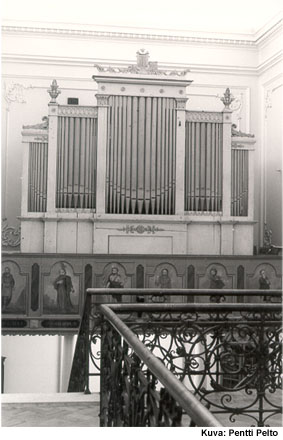|
HISTORICAL ORGANS IN FINLAND 
Kuorevesi, Häme Museum- Thulé, Anders 1856
- 7 stops, 1 manual and pull-down pedal
- mechanical action and mechanical stop action
The organ built by Anders Thulé in Kuorevesi Church was completed in 1856, during the Crimean War. Bror Axel Thulé wrote in his memoirs that the organ came cheap. The drawings are dated November 25, 1854, and according to the then current practice, they were approved by the Czar himself on May 15, 1855. The organ was inspected by organist G.A. Weckman from Hämeenlinna on August 30, 1856. The instrument was used in Kuorevesi Church (built by Matti Åkerblom in 1779) until 1915, when a new instrument was built and the old one was stored in Häme Museum. At the museum, the organ was played in recitals a few times, but in 1993 the instrument was dismantled and put into storage.
The Kuorevesi organ is the oldest Finnish church organ to have survived in exactly its original state. Not even a blower has been added. It is awaiting rebuilding and the care of an understanding organist.
Structure
The façade consists of five oblong flats, of which the middle one is the largest, being about eight feet high. The beam above it is decorated with rosettes of the kind that appear in later Thulé façades too. Also above this flat is a lyre decoration, with vases flanking it. The curved lines of mouths enliven the otherwise rather ascetic appearance. The low cost of the organ is evident in the façade pipes, which are made of wood and painted silver-bronze.
The organ case is a simple frame structure with no top. In its middle is the chest, with plenty of space around it. Beneath the chest is a double bellows. Its lower, wedge-shaped half is the feeder bellows, operated with a pumping pedal, and the upper, also wedge-shaped, half is the reservoir. The console is on the left wall of the organ behind the outermost flat. The pumping pedal and its machinery is on the right wall of the organ, concealed behind the outermost flat on that side.
Technical features
The sponselled slider chest is large, spacious and crafted with exceptional precision. All six stops are housed on top of it. The grooves in the chest are separated with double bars to prevent leakage. The action passes from the console through a horizontal rollerboard to the pallets. All components of the action are precisely crafted and carefully finished.
The stop action is short and simple, since the sliders extend close to the music stand below which the stop knobs are located. The knobs have porcelain labels with printed stop titles. The seat is upholstered in leather and decorated with a crenellated strip.
The compass of the manual is typical for the builder and the era. The naturals have an ebony covering, while the sharps have an ivory covering. The pedal is limited in modern terms, only an octave and a half, but this was the practice of Anders Thulé until the 1860s.
The metal pipes of the organ are roughly finished. The sheet metal is of varying thickness, and the soldered seams are uneven. Perhaps Anders Thulé was training a new pipe-maker; we will never know. The open metal pipes have tuning flaps, which was Anders Thulé’s practice until the 1860s. This instrument and the Sund organ are the only Finnish instruments in which this device has been preserved. The flap is formed from the upper end of the body of the pipe by cutting the front horizontally slightly over halfway and by cutting the longer back into a rectangular flap. The flap is then bent over the pipe at an angle of about 45 degrees. Only stopped pipes have ears. The tin content of the alloy used is about 40%. The square wood pipes are meticulously and precisely crafted.
Musical properties
The organ has a limited number of stops, but they are sufficient for varied and rich registration. All the necessary stops are represented. The Principals (8’, 4’, 3’, 2’) form a foundation complemented by a great flute and a violin stop.
The soft and full-bodied sound is due to the high mouths, which yields a naturally strong sound. This enables pipe activation (the volume of air) to be kept low, which in turn produces a sound that is strong on the fundamental. This is a feature typical of the church organs of Anders Thulé, and it survived in the early work of his son, Bror Axel Thulé.
The characteristic features of the Anders Thulé sound are clearly audible in the Kuorevesi organ: a balance favouring the extremes, bass and soprano; a warm and full-bodied tone; and an excellent blend between stops. We may well imagine that Thulé had choral texture in mind when building the organ. Indeed, the instrument is at its best in accompanying congregational hymn-singing.
The Dubbelflöjt and Salicional share the same wood pipes in the great octave. The original tender, dated November 29, 1854, includes a Fugara stop, but the stop knob reads Salicional. The mensuration of the stop, however, is more like that of Fugara.
Disposition
Manual C-f3 |
|
|
Principal 8 fot | | |
Dubbelfleut 8 f | | |
Salicional 8 f | | |
Octava 4 f | | |
Qvinta 3 f | | |
Octava 2 f | | |
| | |
| | |
| | |
| | |
Pull-down pedals C-g0 | | |
| | |
| | |
|
|
|
Cut-out valve | | |
Calcant [bellows signal bell] | | |
| | |
| | |
| | |
| | |
| | |
| | |
| | |
| | |
| | |
| | |
| | |
|